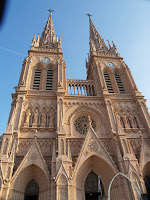Luján is best known for its large neo-gothic Basilica, built in honor of the Virgin of Luján, the patron saint of Argentina.
Posted by Hugo Rep
Posted on August 06, 2011
with No comments
Luján is best known for its large neo-gothic Basilica, built in honor of the Virgin of Luján, the patron saint of Argentina.
Every year, more than six million people make pilgrimages to the Basilica, many walking there from Buenos Aires. The city is known as 'La Capital de la Fe' (Capital of the Faith).
It is popular day-trip for non-believers too, with abundant grill restaurants (like most places in Argentina) and souvenir shops with kitsch religious memorabilia.
The church was designed by the French architect Ulderico Courtois and started in 1889, completed by 1937. Its towers stand 106m high and it has a copper roof and bronze doors.
The huge church towers over the surrounding flat country and houses the tiny 38 cm high statue of the Virgin. A large and important organ by French builder Cavaille-Coll stands in the gallery in a state of deterioration, although efforts are underway to see to its restoration.
Luján is also home to the Enrique Udaondo museum complex, housing exhibitions of colonial life in the house of the Viceroy and old town hall, with art, uniforms, silverware and transport with many antique vehicles including Plus Ultra the first hydroplane to cross from Europe to Argentina and La Porteña, Argentina's first steam locomotive operated by Ferrocarril Oeste. Also on display are the prison cells where Colonel William Carr Beresford, commander of the 1806 British invading forces, and General Cornelio Saavedra, president of the first national government (Primera Junta) in 1810, were held.
The nearby city of Mercedes is seat of the Bishop of Mercedes and Luján. Luján is the principal settlement of the Lujan Partido or municipality. The city has a railway and bus station and is easily reached from Buenos Aires.
Every year, more than six million people make pilgrimages to the Basilica, many walking there from Buenos Aires. The city is known as 'La Capital de la Fe' (Capital of the Faith).
It is popular day-trip for non-believers too, with abundant grill restaurants (like most places in Argentina) and souvenir shops with kitsch religious memorabilia.
The church was designed by the French architect Ulderico Courtois and started in 1889, completed by 1937. Its towers stand 106m high and it has a copper roof and bronze doors.
The huge church towers over the surrounding flat country and houses the tiny 38 cm high statue of the Virgin. A large and important organ by French builder Cavaille-Coll stands in the gallery in a state of deterioration, although efforts are underway to see to its restoration.
Luján is also home to the Enrique Udaondo museum complex, housing exhibitions of colonial life in the house of the Viceroy and old town hall, with art, uniforms, silverware and transport with many antique vehicles including Plus Ultra the first hydroplane to cross from Europe to Argentina and La Porteña, Argentina's first steam locomotive operated by Ferrocarril Oeste. Also on display are the prison cells where Colonel William Carr Beresford, commander of the 1806 British invading forces, and General Cornelio Saavedra, president of the first national government (Primera Junta) in 1810, were held.
The nearby city of Mercedes is seat of the Bishop of Mercedes and Luján. Luján is the principal settlement of the Lujan Partido or municipality. The city has a railway and bus station and is easily reached from Buenos Aires.
I hope you enjoyed this book. If you have any questions, or want to supplement this post, please write in the comments area. You can also visit Facebook, Twitter, Linkedin, Instagram, Pinterest and Feedly where you'll find further information in this blog. SHARE THIS!
Etichette:
Buenos Aires,
Churchs and Cathedrals






















0 comments:
Post a Comment
Do not insert clickable links or your comment will be deleted. Check the Notify me notifications to be notified via email of new comments. If I helped you with the post or with the answers to the comments, share on Facebook or Twitter. Thank you.